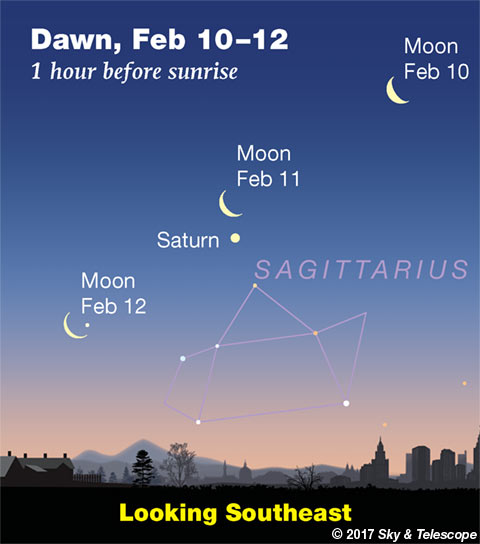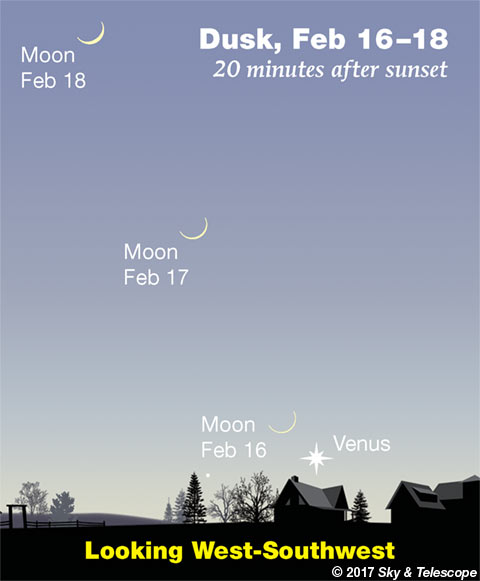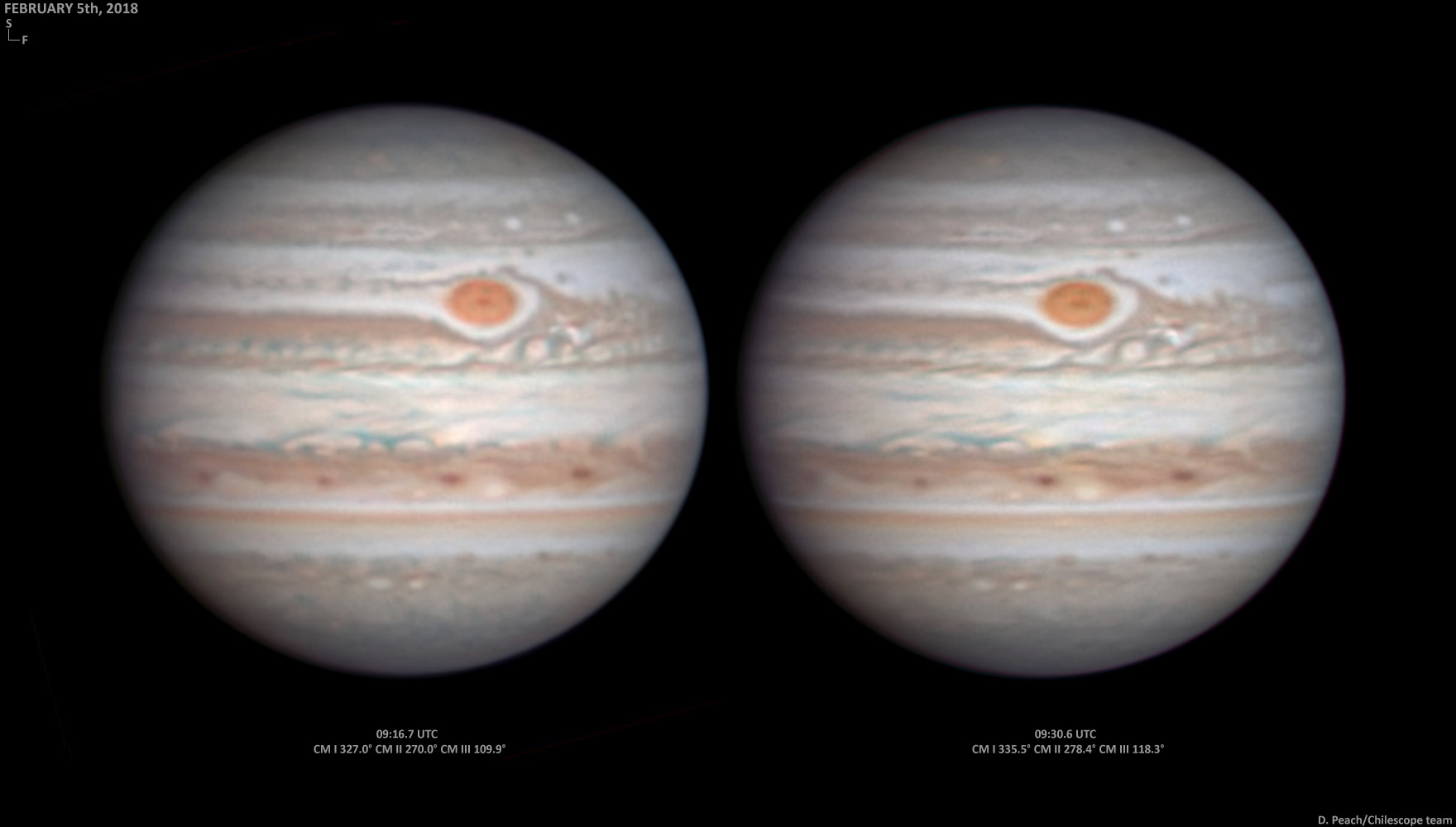Friday, February 9
• By 9 p.m. the Big Dipper stands straight up on its handle in the northeast. In the northwest, the W of Cassiopeia also stands on end at about the same height.
Saturday, February 10
• Sirius the Dog Star blazes high in the southeast after dinnertime; it's the brightest star of Canis Major. In a dark sky with lots of stars visible, the constellation's points can be connected to form a convincing dog profile. He's currently standing on his hind legs; Sirius is on his chest.
But seen through the light pollution where most of us live, only his five brightest stars are easily visible. These form a short-handled meat cleaver. Sirius is the cleaver's top back corner, its blade faces to the right, and its stubby handle is down below pointing lower left.

• As dawn begins on Sunday the 11th, look low in the southeast for the waning crescent Moon hanging just a couple degrees above distant Saturn, about as shown here. These diagrams are always drawn exact for a viewer at latitude 40° north, longitude 90° west (near the middle of North America), but they're generally close enough for the rest of the U.S. and populated parts of Canada.
Sunday, February 11
• Orion now stands high in the south after dinnertime. Lower left of it blazes Sirius, and farther left of Orion shines Procyon. Extending up from Procyon is dim little Canis Minor: the doglet whose top is barely visible in profile in a dark sky. He's currently vertical, standing on invisible hind legs. We only see stars marking the outline of his back, neck, and head, in profile. Procyon is his rump.
Monday, February 12
• How well do you know the many lesser telescopic sights around Orion's Belt, Sword, and Club? Explore them during this dark-of-the-Moon week using Sue French's Deep-Sky Wonders article, charts, and photos in the February Sky & Telescope, page 54.
Tuesday, February 13
• High in the northern sky these evenings, in the seemingly empty wastes between Capella overhead and Polaris due north, sprawls big, dim Camelopardalis, the Giraffe — perhaps the biggest often-visible constellation you don't know. Unless you have a really dark sky, you'll need binoculars to work out its nondescript pattern using the constellation chart in the center of Sky & Telescope — a challenge project that will build your skills for correctly relating what you see in binoculars to what you see, much smaller, on a sky map.
If you're new at this, start with brighter, easier constellations and save the shy Giraffe until you get good at this.
Wednesday, February 14
• Right after dark the W of Cassiopeia shines high in the northwest, standing almost on end. The brightest star between Cassiopeia and the zenith, at that time for the world's mid-northern latitudes, is Alpha Persei (Mirfak). Around and upper left of it is the Perseus OB1 Association: a loose swarm of modest stars about the size of your thumbtip at arm's length. They show well in binoculars.
A stellar association is a group of stars born around the same place and time but too large and loose to hold together gravitationally as a star cluster.
Thursday, February 15
• Under the feet of Orion, and to the right of Sirius now, hides Lepus the Hare. Like Canis Major, this is a constellation with a connect-the-dots that looks like what it's supposed to. He's a crouching bunny, with his nose pointing lower right, his faint ears extending up toward Rigel (Orion's western foot), and his body bunched to the left. His brightest two stars, 3rd-magnitude Beta and Alpha Leporis, form the front and back of his neck.
• New Moon (exact at 4:04 p.m. EST). The Moon partially eclipses the Sun for southern South America and much of Antarctica.

Friday, February 16
• About 15 to 20 minutes after sunset, use binoculars to look just above the west-southwest horizon for Venus and a super-thin crescent Moon (only a little more than 24 hours old for North America), as shown at right.
Saturday, February 17
• Now the waxing crescent Moon is easier to see in the west-southwest after sunset. Its curved side points the way down toward Venus, as shown at right.
________________________
Want to become a better astronomer? Learn your way around the constellations! They're the key to locating everything fainter and deeper to hunt with binoculars or a telescope.
This is an outdoor nature hobby. For an easy-to-use constellation guide covering the whole evening sky, use the big monthly map in the center of each issue of Sky & Telescope, the essential guide to astronomy.

Once you get a telescope, to put it to good use you'll need a detailed, large-scale sky atlas (set of charts). The basic standard is the Pocket Sky Atlas (in either the original or Jumbo Edition), which shows stars to magnitude 7.6.
Next up is the larger and deeper Sky Atlas 2000.0, plotting stars to magnitude 8.5; nearly three times as many. The next up, once you know your way around, is the even larger Uranometria 2000.0 (stars to magnitude 9.75). And read how to use sky charts with a telescope.
You'll also want a good deep-sky guidebook, such as Sue French's Deep-Sky Wonders collection (which includes its own charts), Sky Atlas 2000.0 Companion by Strong and Sinnott, or the bigger Night Sky Observer's Guide by Kepple and Sanner.
Can a computerized telescope replace charts? Not for beginners, I don't think, and not on mounts and tripods that are less than top-quality mechanically (meaning heavy and expensive). And as Terence Dickinson and Alan Dyer say in their Backyard Astronomer's Guide, "A full appreciation of the universe cannot come without developing the skills to find things in the sky and understanding how the sky works. This knowledge comes only by spending time under the stars with star maps in hand."
This Week's Planet Roundup

Mercury is hidden in conjunction with the Sun.
Venus is barely beginning to emerge into view low in the afterglow of sunset. It's a challenge! If the air is very clear, look for it just above your west-southwest horizon 10 to 20 minutes after your local sunset time. Bring binoculars.
On what day will you first see it? Venus is just beginning an "Evening Star" apparition that will continue through next summer.
Mars and Jupiter (magnitudes +1.0 and –2.1, respectively) rise in the east-southeast in the hours after midnight: around 1 a.m. and 2:30 a.m., respectively, depending on your location. By early dawn they're high in the south. Jupiter is the brightest point in the pre-dawn sky, shining in dim Libra. Mars glows almost 20° to Jupiter's lower left, to the left of the head of Scorpius.
Below or lower left of Mars this week is Mars-colored Antares, equally bright.
Saturn (magnitude +0.5, in Sagittarius) glows with a steady light low in the southeast in early dawn. Draw a line from Jupiter through Mars, extend the line farther by a little more than the Jupiter-Mars separation, and there's Saturn.
Uranus (magnitude 5.9, in Pisces) is still fairly high in the southwest right after the end of twilight. Finder chart.
Neptune (magnitude 8.0, in Aquarius) is getting lost in the sunset.
______________________
All descriptions that relate to your horizon — including the words up, down, right, and left — are written for the world's mid-northern latitudes. Descriptions that also depend on longitude (mainly Moon positions) are for North America.
Eastern Standard Time (EST) is Universal Time (also called UT, UTC, GMT, or Z time) minus 5 hours.
______________________
"The dangers of not thinking clearly are much greater now than ever before. It's not that there's something new in our way of thinking, it's that credulous and confused thinking can be much more lethal in ways it was never before."
— Carl Sagan, 1996
______________________
"Objective reality exists. Facts are often determinable. Vaccines save lives. Carbon dioxide warms the globe. Bacteria evolve to thwart antibiotics, because evolution. Science and reason are not fake news, not a political conspiracy. Civilization's survival depends on our ability, and willingness, to use them."
— Alan MacRobert, your Sky at a Glance editor
______________________
"Facts are stubborn things."
— John Adams, 1770
______________________
"The most damaging consequences of [the current] Truth Decay include the erosion of civil discourse, political paralysis, alienation and disengagement of individuals from political and civic institutions, and uncertainty over national policy."
— RAND Corporation report, January 2018
 8
8








Comments
Jakob
February 12, 2018 at 4:01 pm
On the evening of feb 5th I did locate Venus in my 8 x 40 binoculars. Despite perfect skies our sister planet could not be seen without optical aid. At the time Venus' elongation was 6.7° from our star. I will try again on the 14th when good weather will arrive
You must be logged in to post a comment.
mary beth
February 12, 2018 at 8:54 pm
Hope you get to see it. Let us know
You must be logged in to post a comment.
Jakob
February 14, 2018 at 11:56 am
No luck this evening..too much haze. J
You must be logged in to post a comment.
mary beth
February 14, 2018 at 2:56 pm
Sorry to hear, hopefully clear skies will come your way soon. At least Venus will be visible almost all year. I'm excited about watching it and also viewing the planets near Scorpius this summer! Do you live in a latitude where you can see it?
You must be logged in to post a comment.
Jakob
February 15, 2018 at 3:18 am
Mary,
I live in Sweden at 56° where the splendor of Scorpius does not show. During my summer vacation I travel to Crete and enjoy the summer constellations. This summer will be most enjoyable with Mars and Saturn. Wish you clear skies. Jakob
You must be logged in to post a comment.
mary beth
February 15, 2018 at 11:36 am
I assumed you were from a Scandinavian country by the way you spelled your name. That sounds like a beautiful summer vacation. You'll have to comment on here so I can read about your viewing. Two of my favorite bands are from Scandinavia – The Raveonettes and I Was A King. Living in south Texas, I am fascinated by the images of all the snow and northern lights in your country. Wishing you clear skies as well!
You must be logged in to post a comment.
Jakob
February 15, 2018 at 5:28 pm
I Will keep you informed (-:
You must be logged in to post a comment.
Jakob
February 25, 2018 at 12:17 pm
At last I got my eyes on Venus, we have had a sunny and cold day so it was easy finding her at sunset. 17.54 pm she was obvious (-: J
You must be logged in to post a comment.
You must be logged in to post a comment.